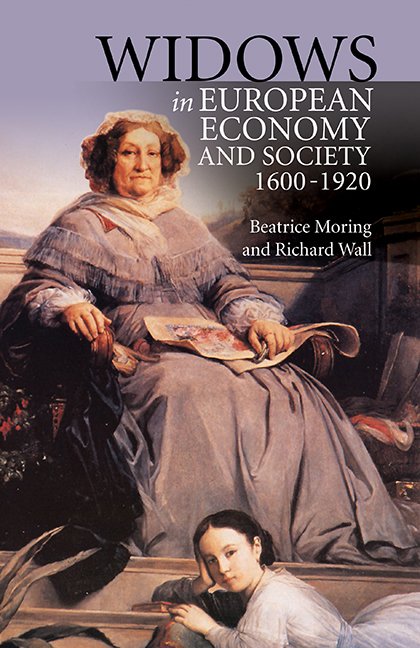Book contents
- Frontmatter
- Contents
- List of Plates
- List of Tables
- Acknowledgements
- Introduction
- 1 Widows and Poverty
- 2 Widows, Legislation and Property
- 3 Assessing the Assets of the Widow
- 4 Life Interest, Usufruct or Pension, The Mainstay of the Widow?
- 5 Urban Widows, Economy and Family
- 6 The Demography of Widowhood
- 7 Household Structure, Age, Social Status and Geography
- Conclusion
- Appendices
- Appendix 1 Abandonment
- Appendix 2 Widows and Poverty
- Appendix 3 Brief Life Histories of Poor Widows
- Appendix 4 Widows and Property
- Appendix 5 Contracts
- Appendix 6 Widows, Family and Work
- Appendix 7 Demography
- Appendix 8 Households
- Bibliography
Appendix 3 - Brief Life Histories of Poor Widows
from Appendices
Published online by Cambridge University Press: 30 August 2017
- Frontmatter
- Contents
- List of Plates
- List of Tables
- Acknowledgements
- Introduction
- 1 Widows and Poverty
- 2 Widows, Legislation and Property
- 3 Assessing the Assets of the Widow
- 4 Life Interest, Usufruct or Pension, The Mainstay of the Widow?
- 5 Urban Widows, Economy and Family
- 6 The Demography of Widowhood
- 7 Household Structure, Age, Social Status and Geography
- Conclusion
- Appendices
- Appendix 1 Abandonment
- Appendix 2 Widows and Poverty
- Appendix 3 Brief Life Histories of Poor Widows
- Appendix 4 Widows and Property
- Appendix 5 Contracts
- Appendix 6 Widows, Family and Work
- Appendix 7 Demography
- Appendix 8 Households
- Bibliography
Summary
The brief life histories of some widows, part of a cohort (of 310 widows) married between 1740 and 1810 in western Finland, were studied longitudinally. Of the cohort, fourteen percent ended their days as inmates on temporary or permanent relief. While the question of social origin was of vital importance for their destiny, even in this group family members played an important part in later life. Residence with daughter:
‘Anna Henrichsdotter was born in 1745; her father was a boatman in the navy. She married the younger son of a farmer at the age of 23. Her husband worked as a farmhand and died after three years of marriage. She was left with three daughters aged 3, 2 and 0 years. Anna never remarried and struggled on as a cottager until her daughters grew up. The eldest married a crofter and the second daughter died in her thirties. The youngest daughter married a boatman and had six children. Mother and daughter never parted company, and Anna lived with the family of the boatman until she died at the age of 75. The parish assisted Anna with poor-relief payments.’
‘Anna Erichsdotter was born in 1768 of a farming family but died as a parish pauper. Her husband was a boatman (m. 1796). Two of her children died as infants and one daughter migrated soon after the death of her father. One daughter never married and stayed with her mother. Anna died at the age of 92, blind and the oldest resident in the parish. The daughter survived into her eighties.’
Residence with son:
‘Margreta Andersdotter was a tailor's daughter. She married a cottager at the age of 31. The family had two daughters and a son. Both daughters married crofters and continued to live in the parish. During the seventeen years of her widowhood Margreta resided with her son, who had managed to acquire a croft. The family did not prosper, however. Not only the mother but also the son ended their days as parish paupers.’
- Type
- Chapter
- Information
- Widows in European Economy and Society, 1600-1920 , pp. 264 - 266Publisher: Boydell & BrewerPrint publication year: 2017



